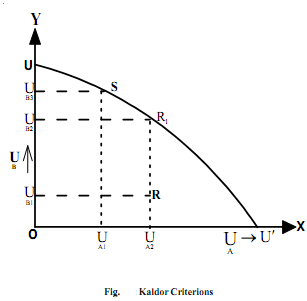Kaldor-Hicks Criteria:
In Kaldor's words, in all cases where a certain policy leads to an increase in physical productivity and thus of aggregate real income it is possible to make everybody better off than before, or at any rate to make some people better off without making any body worse off, it is quite sufficient to show that even if all those who suffer as a result are fully compensated for their loss, the rest of the community will still be better than before.

In the Figure represents the utility possibility frontier, which is the locus of the points representing the different combinations of utility obtained by A and B in the society and the maximum possible under the resource constraint. Suppose due to the change in policy there is a movement from the point R to S. We see that it results in the gain of B and loss of A in terms of utility. Suppose the gainer B is
prepared to compensate the looser A fully and so moves from the point S to the point R1 on the utility possibility frontier, yet B gains n terms of utility of the vertical distance( UB1UB2) UU According to Kaldor in this case change in policy leads to increase in welfare. Hicks formulates his criterion in a different orientation. Due to the change in policy if B gains and A looses and if the looser A cannot profitably bribe the gainer B so that B will not insist on the policy change, then according to Hicks the change in policy leads to increase in the welfare, which means B's gain is greater than A's loss.